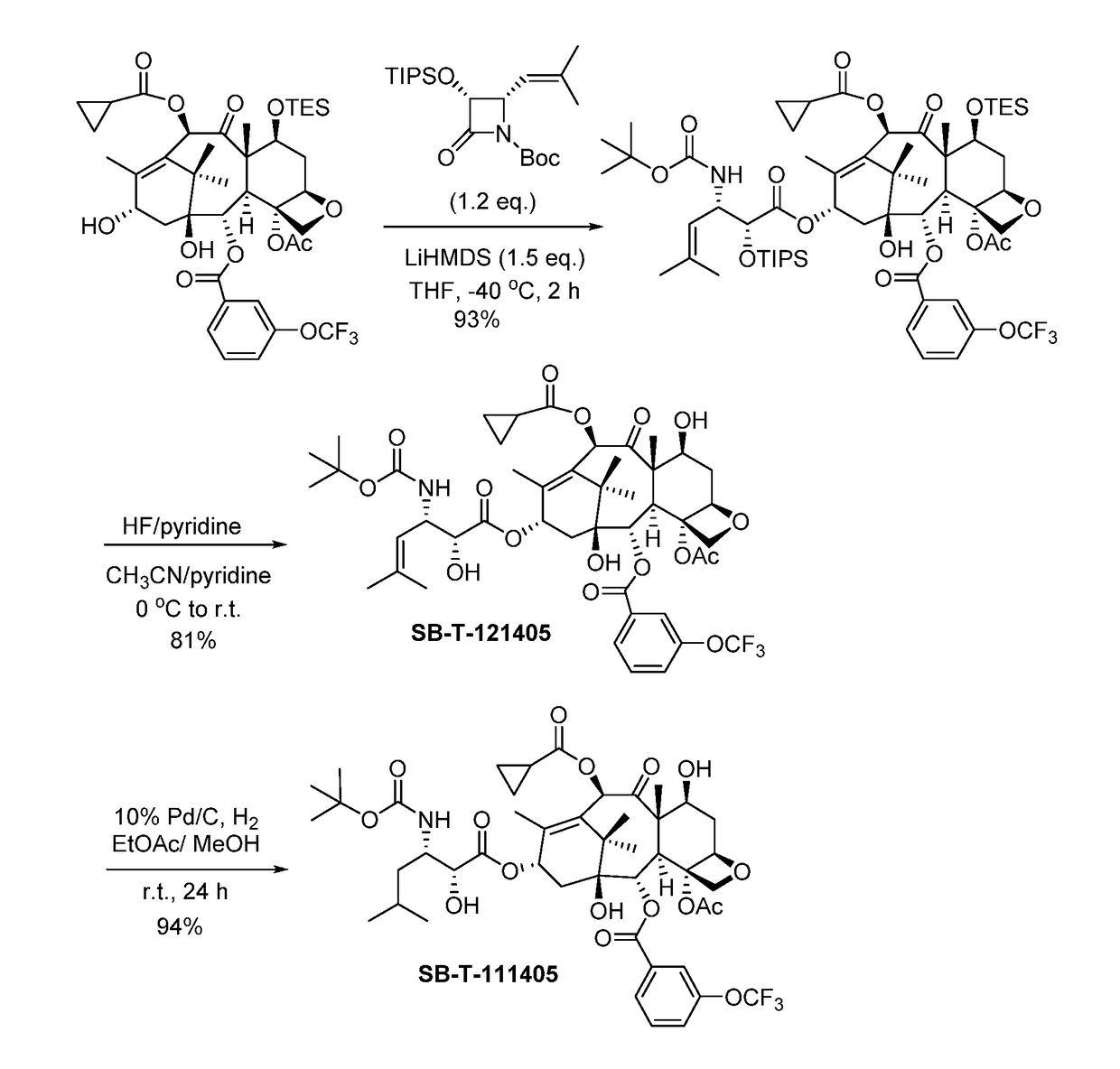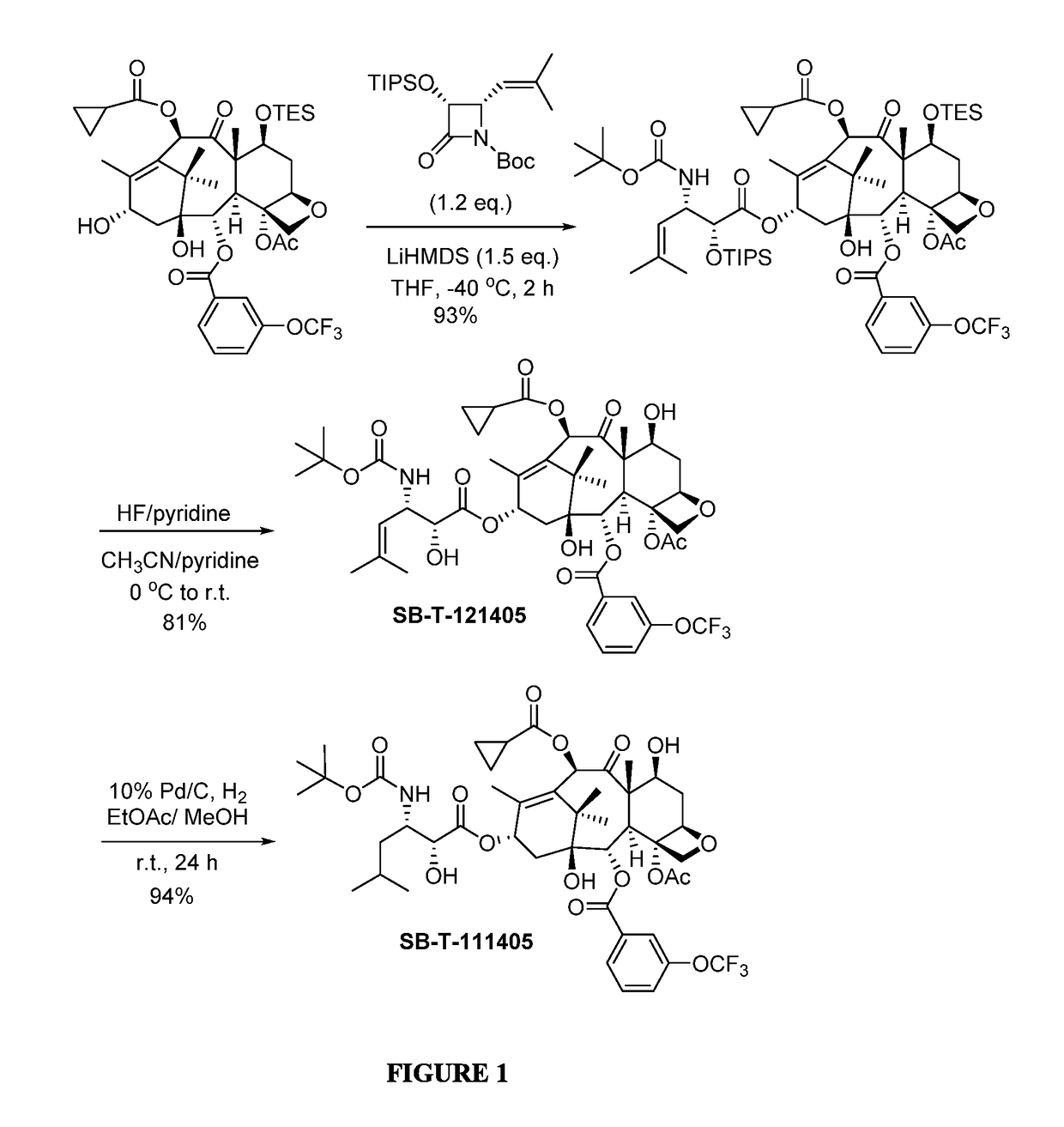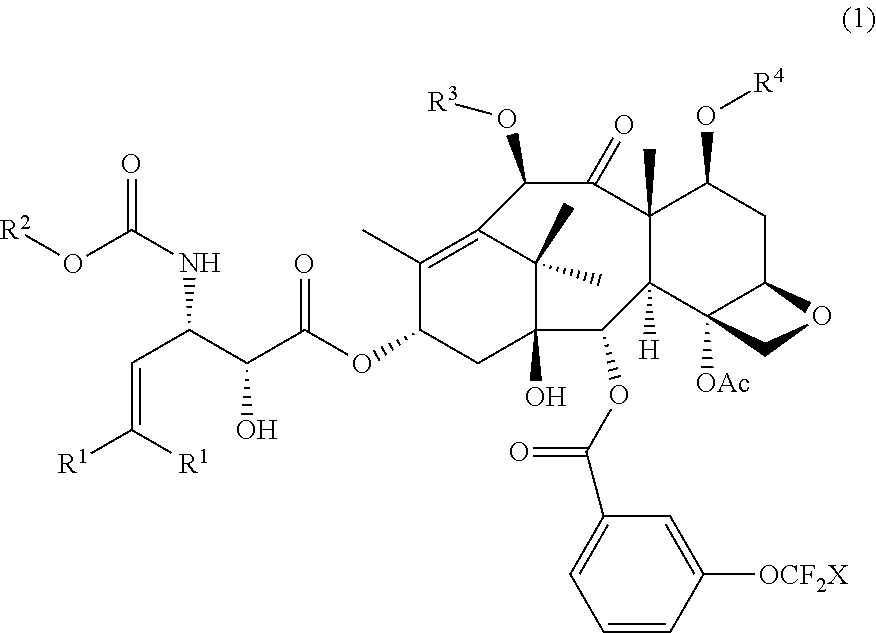Third Generation Taxoids and Methods of Using Same
a technology of taxoids and taxane, which is applied in the field of third generation taxoids, can solve the problems that the first-generation taxane anticancer drugs exhibit little efficacy in treating melanoma, pancreatic, gastric, brain and renal cancer, etc., and achieves the effects of increasing the potency, reducing the potency, and high potency
- Summary
- Abstract
- Description
- Claims
- Application Information
AI Technical Summary
Benefits of technology
Problems solved by technology
Method used
Image
Examples
example 1
2-Debenzoyl-2-(3-trifluromethoxybenzoyl)-3′-dephenyl-10-(cyclopropanlcarbonyl)-3′-(2-methyl-2-propenyl)docetaxel (SB-T-121405)
[0075]2-Debenzoyl-2-(3-trifluromethoxybenzoyl)-7-triethylsilyl-10-deacetyl-10-cyclo-propanecarbonyl-baccatin [Ref 1] (122 mg, 0.151 mmol, 1 eq.) was dissolved in 8 mL dry tetrahydrofuran (THF) and cooled to −40° C. 1M lithium hexamethyldisilazide (LiHMDS) in THF (0.22 mL, 0.220 mmol, 1.5 eq.) and (3R,4S)-1-tert-butoxycarbonyl-3-triisopropyloxy-4-(2-methylprop-1-enyl)azetidin-2-one [Ref 2] (72 mg, 0.181 mmol, 1.2 eq.) were added into the mixture sequentially. The reaction was kept at −40° C. and monitored via thin-layer chromatography (TLC). Upon completion, the reaction was quenched by saturated ammonium chloride (5 mL), and the reaction mixture was extracted by ethyl acetate (3×5 mL), washed by saturated brine (5 mL), dried over anhydrous magnesium sulfate and concentrated in vacuo to give crude product. Further purification was made by column chromatography...
example 2
2-Debenzoyl-2-(3-trifluromethoxybenzoyl)-3′-dephenyl-10-(cyclopropanecarbonyl)-3′-(2-methylpropyl)docetaxel (SB-T-111405)
[0079]To a solution of SB-T-121405 (50 mg, 0.0578 mmo) in 25 mL ethyl acetate and 0.05 mL methanol was added 10% palladium on carbon (6 mg, 0.0058 mmol, 0.1 eq.) at room temperature. The mixture was stirred at room temperature for 24 hours. The progress of the reaction was monitored by mass spectroscopy. Upon completion, the reaction mixture was filtered through celite pad, and washed with ethyl acetate (3×5 mL). The combined solution was washed with saturated copper sulfate (4 mL) and brine (4 mL), dried over anhydrous magnesium sulfate and concentrated in vacuo to give crude product. Purification column chromatography on silica gel (hexanes:ethyl acetate=1:1) gave 2-debenzoyl-2-(3-trifluromethoxybenzoyl)-3′-dephenyl-10-(cyclopropanlcarbonyl)-3′-(2-methyl-2-propanyl)-docetaxel (SB-T-111405) (47 mg, 94% yield) as a white solid; 1H NMR (400 MHz, CDCl3) δ 0.96-0.99 ...
example 3
[0080]Other third-generation taxoids bearing a 3-trifluoromethoxybenzoyl group at the C2 position were synthesized and characterized in a similar manner as described in Examples 1 and 2.
2-Debenzoyl-2-(3-trifluromethoxybenzoyl)-3′-dephenyl-10-acetyl-3′-(2-methyl-2-propenyl)docetaxel (SB-T-121205)
[0081]White solid; 1H-NMR (400 MHz, CDCl3, ppm) δ 1.14 (s, 3H), 1.25 (s, 3H), 1.33 (s, 9H), 1.66 (s, 3H), 1.73 (s, 9H), 1.75 (s, 3H), 1.84-1.90 (m, 5H), 2.23 (s, 3H), 2.33-2.41 (m, 5H), 2.52-2.58 (m, 1H), 3.47 (bs, 1H), 3.82 (d, J=7.0 Hz, 1H), 4.09-4.19 (m, 2H), 4.26 (d, J=8.3 Hz, 1H), 4.41 (dd, J=10.7 Hz, 7.0 Hz, 1H), 4.70-4.75 (m, 1H), 4.85 (d, J=8.3 Hz, 1H), 4.97 (d, J=8.3 Hz, 1H), 5.32 (d, J=8.3 Hz, 1H), 5.64 (d, J=7.0 Hz, 1H), 6.13 (t, J=8.3 Hz, 1H), 6.31 (s, 1H), 7.44 (d, J=8.0 Hz, 1H), 7.51 (t, J=8.0 Hz, 1H), 7.96 (s, 1H), 8.02 (d, J=8.0 Hz, 1H); 13C-NMR (100 MHz, CDCl3) δ 9.66, 14.34, 15.12, 18.53, 21.00, 21.19, 21.94, 22.32, 25.81, 26.74, 28.35, 35.59, 35.73, 43.32, 45.87, 51.76, 58....
PUM
| Property | Measurement | Unit |
|---|---|---|
| multi-drug resistance | aaaaa | aaaaa |
| metabolic stability | aaaaa | aaaaa |
| permeability | aaaaa | aaaaa |
Abstract
Description
Claims
Application Information
 Login to View More
Login to View More - R&D
- Intellectual Property
- Life Sciences
- Materials
- Tech Scout
- Unparalleled Data Quality
- Higher Quality Content
- 60% Fewer Hallucinations
Browse by: Latest US Patents, China's latest patents, Technical Efficacy Thesaurus, Application Domain, Technology Topic, Popular Technical Reports.
© 2025 PatSnap. All rights reserved.Legal|Privacy policy|Modern Slavery Act Transparency Statement|Sitemap|About US| Contact US: help@patsnap.com



